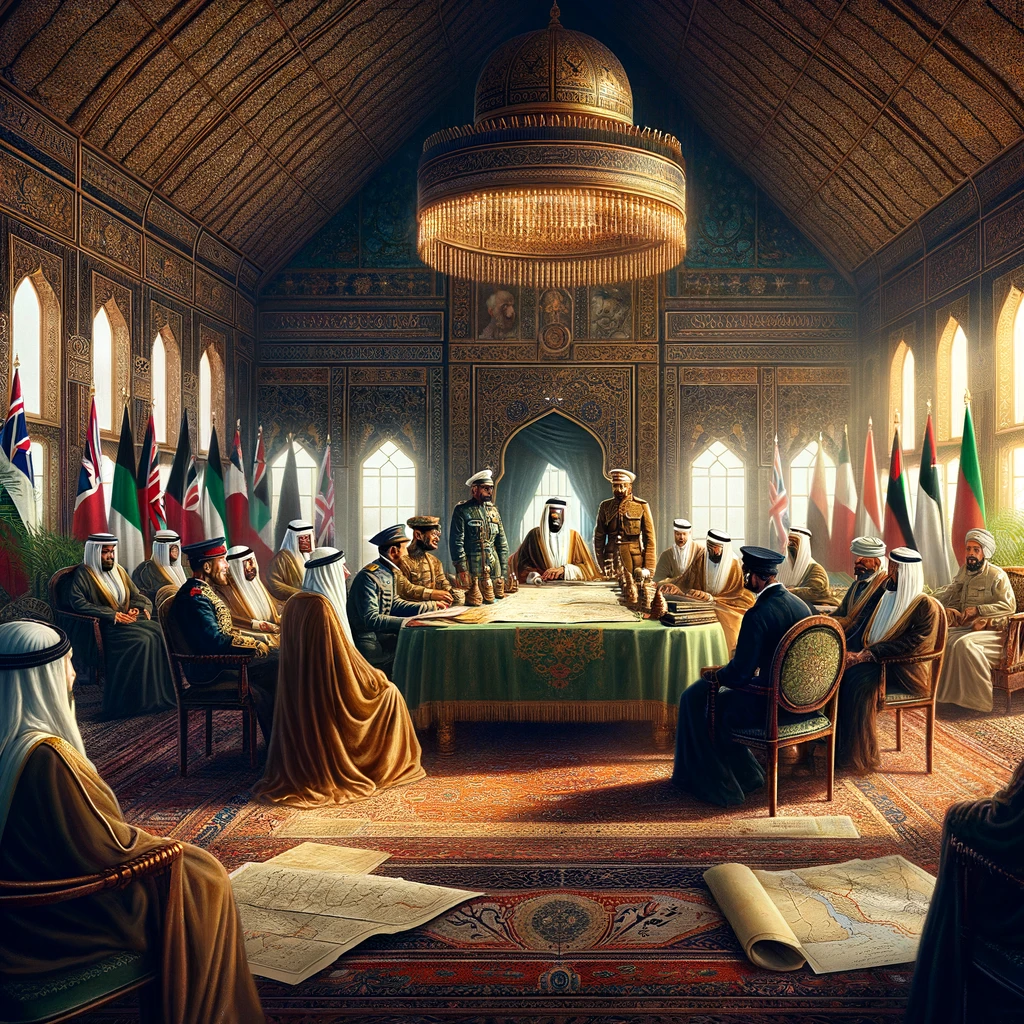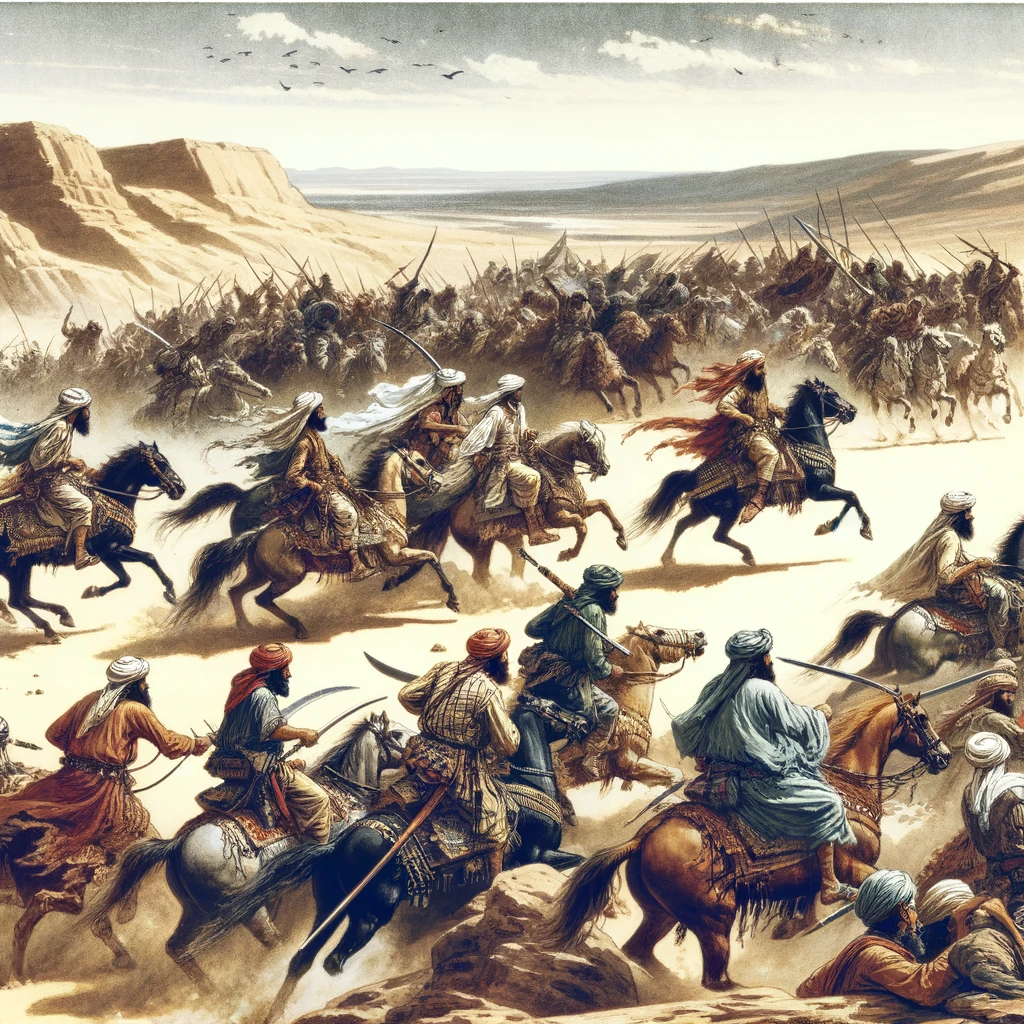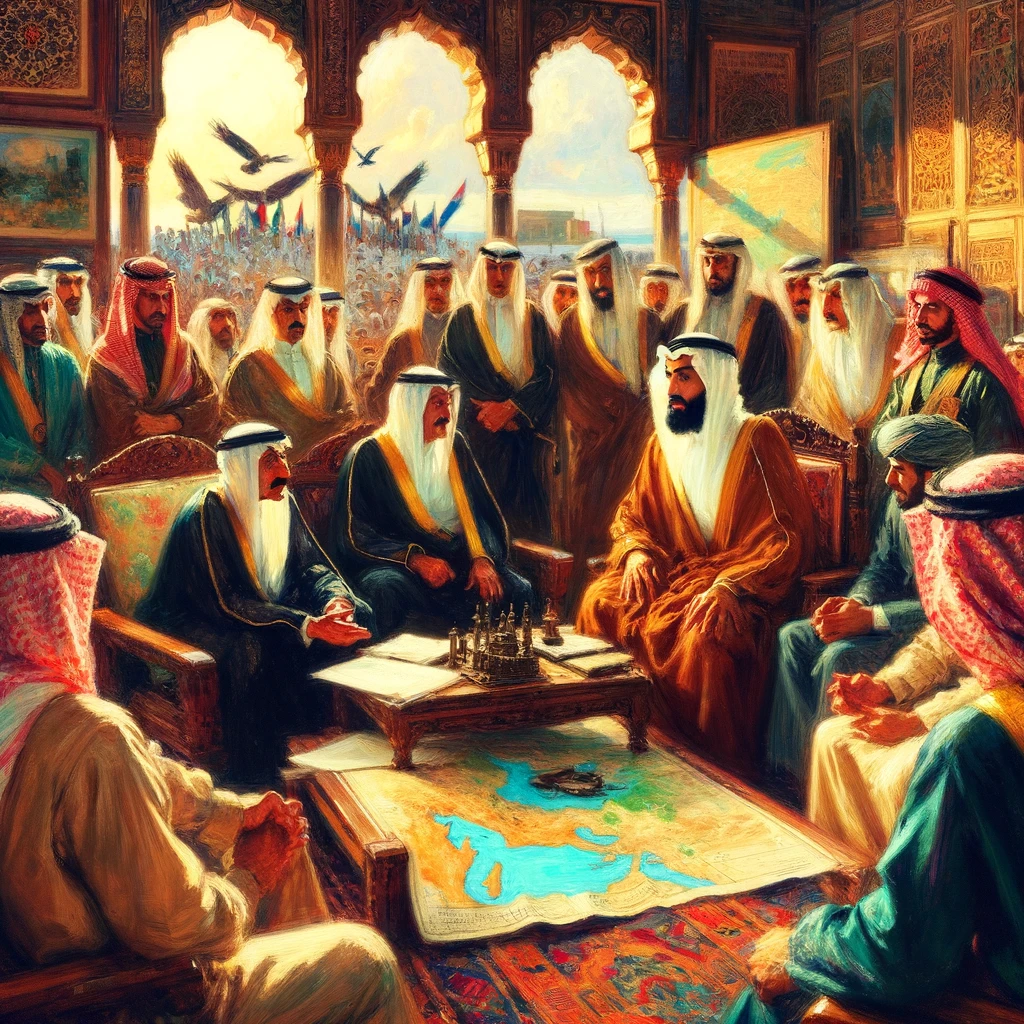In the early 20th century, Harry St. John Philby, an eminent British civil servant and writer, embarked on an extensive journey through the Arabian Peninsula, which culminated in the publication of his seminal work, “Arabia.” This book offers a meticulous account of his experiences and observations, shedding light on the socio-political dynamics, cultural practices, and geographical landscapes of the nascent state of Saudi Arabia. Among the noteworthy figures featured in his narrative are Ibn Sa’ud, the founder of modern Saudi Arabia, and various tribes such as the Harb, Ajman and Mutair. Philby’s narrative spans a range of locations from the Wahhabi state to the Hijaz railway, Kuwait, and beyond, providing a comprehensive overview of Arabia during a pivotal period in its history.
- The smuggling of ammunition highlighted the challenges of maintaining regional security.
- Tribal conflicts and diplomatic maneuvering were central to the political landscape of early 20th-century Arabia.
- Shaikh Salim Al Sabah’s actions illustrate the complex interplay of financial and political motivations.
- The raid by Shammar and ‘Ajman tribes underscores the volatile security environment.
- The Arabian Peninsula was a region of fluid loyalties and frequent skirmishes, shaped by both internal dynamics and external influences.
Arabian Power Struggles
In 1918, Ibn Saud was far from being the supreme authority across the Arabian Peninsula, facing formidable opposition from two primary adversaries: the Hashemite dynasty and the Rashid family. The Hashemites, ruling over Hejaz, presented a significant challenge to Ibn Saud’s aspirations, bolstered by their custodianship of Islam’s holiest sites and a certain degree of British support. Meanwhile, the Rashids, with their stronghold in Hail and much of northern and central Arabia under their control, posed another major obstacle, their power amplified by Ottoman backing. This tripartite rivalry defined the political landscape of the peninsula, making Ibn Saud’s eventual unification of Saudi Arabia a testament to his diplomatic and military acumen in navigating through and overcoming the intricate web of regional politics, tribal alliances, and international interests. Interestingly, Philby recounts several times throughout his narrative that while both rivals were an equal military threat to the Wahabis, It was the hashemites that earned Ibn Saud’s disdain over and above that of the Rashidis.
‘ Remember,’ said Ibn Sa’ud, ‘ we are fighting Ibn Rashid only for your sake, for we have no unsatisfied claims against him. On the contrary it is he who has claims against us for many a casualty in the house of Rashid. The real enemy of Najd, high and low, is the Sharif, and many members of my own household and many of the religious chiefs are displeased with me for allowing the Ikhwan to be attacked (by hashemites) without striking back.
St. John Philby: Arabia
Wahhabi- Hashemite Territorial Borders
In the early 20th century, the Arabian Peninsula was characterised by fluid and undefined borders, with tribal territories and influence zones shifting like the desert sands. Amidst this landscape of uncertain frontiers, Ibn Saud was acutely aware of the threat posed by the Hashemites, who, with their British support, represented a significant challenge to his ambitions. This awareness drove Ibn Saud to seek a formal delineation of borders with the Hashemites, aiming to establish clear and recognized boundaries that could provide a measure of security and stability in the region. His pursuit of such agreements was not only a strategic move to counter the Hashemite influence but also a foundational step towards the creation of a modern state, where territorial sovereignty could be asserted and defended against both internal rivals and external interventions.
The real enemy of Najd, high and low, is the Sharif, and many members of my own household and many of the religious chiefs are displeased with me for allowing the Ikhwan to be attacked without striking back. I keep them quiet by telling them that all will be well. But the Sharif must be forbidden to attack my country. Fix the border between us and tell him not to transgress it.’ I asked him what he would consider a reasonable boundary in relation to such recognisable landmarks as Ashaira, the Rakba plain and the Hadhn range. ‘
He can have all that/ he replied, ‘ and in fact everything from Marran westward. The Hadhn would be the most suitable boundary.’ If only the Sharif could have brought himself in these days to accept a line joining Marran and Turaba by way of the Sha’ba channel, the history of Arabia would have been written on very different lines during the last ten years. But the Sharif’s mind was set on a single object — the utter destruction of the Wahhabi state — and little he dreamed that it was towards the destruction of his own dynasty that he was inexorably working.
St. John Philby: Arabia
Enforcing The British-Saudi Blockade
During World War I, a British-Saudi blockade was imposed on Kuwait, primarily due to perceptions of Sheikh Salem, the Emir of Kuwait, being overly sympathetic towards the Ottoman Empire, which was then at odds with British interests in the region. Ibn Saud, seizing the opportunity, was more than willing to collaborate with the British in this blockade. He viewed the Ottomans, along with their local allies, the Rashids, as formidable adversaries; thus, a blockade that could potentially stem the flow of supplies to these foes was in his interest, promising to weaken their threat significantly. However, the reality on the ground painted a different picture. Despite the official stance, the blockade’s effectiveness was continually undermined by widespread smuggling activities. Throughout Sheikh Salem’s rule, clandestine trade routes flourished, allowing a steady stream of supplies to bypass the blockade and reach Ottoman territories. This situation underscored the challenges of imposing control in a region where loyalty and trade could often transcend political and military alliances.
Salim’s unceasing efforts to undo our blockade cordon had met with unexpected success. Our blockade policy had undergone a complete volte-face. In future there was to be no blockade qua blockade. Salim’s past irregularities had been forgiven in return for his promise that they would not recur. He was made responsible to see that goods did not get into the enemy’s hands.
The people of Najd were to be allowed to buy without restriction, and the only check to be exercised hereafter was to be exercised in Bombay, whence exports would only be allowed in quantities calculated at intervals by the Political Agent at Kuwait on the basis of the normal requirements of the citizens and tribes of Kuwait and of the people of Najd — the latter being reported to him by ’Abdullah Nafisi, the agent of Ibn Sa’ud. It would have been difficult to devise a scheme better calculated to provide the Turks with their requirements, but the Government of India appeared to regard such leakage to the enemy as a minor matter in comparison with a breach with Salim, possibly involving a military occupation of Kuwait.
St. John Philby: Arabia

Ammunition Accountability and Regional Politics
Harry St. John Philby’s encounters with Ibn Sa’ud unveil the intricacies of governance and military prudence within the Wahhabi state in 1918. The author describes one of his visits to Ibn Sa’ud, who was engaged in the meticulous task of auditing ammunition returned by a Bedouin raiding party. Philby notes Ibn Sa’ud’s stern policy of imposing a fine of one Riyal for every unaccounted bullet, a measure aimed at curtailing theft and wasteful use of ammunition. This action reflects Ibn Sa’ud’s broader strategy to maintain strict control over resources, especially in a context where excessive game hunting and celebratory gunfire were heavily discouraged.
The narrative further delves into geopolitical manoeuvring involving the circulation of ammunition across the region. Philby recounts how Ibn ‘Askar, the Amir of Sudair, informed Ibn Sa’ud of a Harb Bedouin group transporting 12,000 rounds of British small-arms ammunition through his territory. These munitions, presumed to be intended for operations against the Hijaz railway, were sourced from the Sharif of Mecca. Demonstrating astute leadership, Ibn ‘Askar, adhering to Ibn Sa’ud’s directives, preemptively acquired the entire consignment, thereby averting its sale in Kuwait—a market known to supply Persian tribesmen across the coast.
Philby’s observations underscore the complexity of arms trading and its implications for regional stability. He highlights Ibn Sa’ud’s proactive measures to secure over 206,000 rounds of ammunition, replacing outdated Turkish munitions previously supplied by the British. Through Philby’s detailed recounting, the reader gains insight into the strategic acumen of Ibn Sa’ud and the intricate web of alliances and rivalries that characterised the Arabian Peninsula’s political landscape during this era.

Security Concerns and Tribal Dynamics
Philby discusses the precarious state of security within Ibn Sa’ud’s territories, particularly highlighting the Eastern Desert’s vulnerability between Kuwait and the Dahna. Philby shares insights into the activities of Dhari Ibn Tawala, who, despite being removed from Philby’s jurisdiction, continued to profit from smuggling operations, blatantly undermining the security efforts in the region. This scenario underscores the challenges faced by Ibn Sa’ud in maintaining order and preventing unauthorised trade with enemy factions.
Philby also sheds light on the tribal unrest that further complicated the security landscape. A notable incident involved an altercation between the ‘Aiwa and Buraih sections of the Mutair tribe over water rights, resulting in casualties and the loss of camels. This conflict exemplifies the intricate tribal relations and the potential for disputes to escalate into violence, posing additional challenges to the stability of Ibn Sa’ud’s rule.
The involvement of Shaikh Salim Al-Sabah of Kuwait in these dynamics is particularly telling. Salim’s attempts to exploit the situation for financial and political gain, such as offering protection to tribes in exchange for taxes, reflect the opportunistic strategies employed by local leaders to enhance their influence. Philby’s account of Salim’s “clumsy diplomacy” and persistent efforts to antagonise Ibn Sa’ud reveal the intricate power plays and alliances that shaped the political environment of the Arabian Peninsula during this period.
Raids and Diplomatic Challenges
In a particularly revealing episode, Philby details a raid conducted by the Shammar and ‘Ajman tribes against a caravan, shedding light on the intricate web of regional politics and the formidable challenges confronting Ibn Sa’ud. This event not only illustrates the volatile security environment but also highlights Ibn Sa’ud’s adeptness in navigating the treacherous waters of tribal alliances and external pressures.
The raid itself, executed with a precision that underscores the raiders’ familiarity with the terrain and their targets, is emblematic of the perennial threats that caravans faced traversing the Arabian Peninsula. Such actions were not merely criminal enterprises but were deeply entwined with the tribal and political dynamics of the region. They served as stark reminders of the ongoing struggle for power, resources, and influence that defined the desert landscape.
Ibn Sa’ud’s response to these challenges was multifaceted, demonstrating his sagacity and diplomatic skill. Recognizing the raid as part of a broader pattern of incursions that threatened the stability of his realm and the safety of its trade routes, Ibn Sa’ud was compelled to address
The incident brings to the fore the impact of external influences on local stability. The involvement of tribes such as the Shammar and ‘Ajman in raids, often encouraged or facilitated by outside entities seeking to undermine Ibn Sa’ud’s authority, underscores the complex interplay between local tribal dynamics and the broader geopolitical strategies of regional and colonial powers.

Through Philby’s account of this raid, we gain insight into the challenges that Ibn Sa’ud faced in asserting his leadership over a fragmented landscape. It highlights not only the internal and external pressures that shaped the politics of the Arabian Peninsula but also the resilience and strategic acumen of Ibn Sa’ud as he sought to forge a unified nation amidst the shifting sands of tribal allegiance and international intrigue.
FAQ
Q: Who was Ibn Sa’ud?
A: Ibn Sa’ud was the founder of modern Saudi Arabia, known for his leadership and diplomatic skills.
Q: What was the purpose of imposing fines for unaccounted ammunition?
A: The fines were meant to curtail theft and prevent wasteful use of ammunition.
Q: Why were tribal conflicts significant in early 20th-century Arabia?
A: They played a key role in the political and security dynamics of the region.
Q: What role did smuggling play in the region’s politics?
A: Smuggling exacerbated security challenges and impacted regional stability.
Q: How did Ibn Sa’ud manage the challenges of tribal alliances?
A: Through diplomatic skill and strategic management of alliances and rivalries.
Q: What impact did external influences have on local stability?
A: They complicated the security environment by fueling tribal raids and undermining authority.

